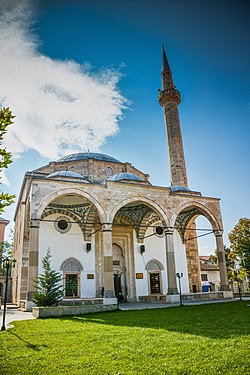| Imperial Mosque Xhamia e Mbretit | |
|---|---|
 | |
| Religion | |
| Affiliation | Sunni Islam |
| Ecclesiastical or organizational status | Open |
| Status | Preserved |
| Location | |
| Location | Pristina |
| Country | Kosovo |
 | |
| Architecture | |
| Type | Ottoman architecture |
| Completed | 1461 |
| Materials | Stone |
The Imperial Mosque, also known as King's Mosque [a] , is an Ottoman mosque located in Pristina, Kosovo. It was built in 1461 by Sultan Mehmed the Conqueror. The inscription written in Arabic alphabet in six rows which is situated in the entry portal as the exact date of construction provides the year 1461, according to the Gregorian calendar, i.e. Hijra 865 year according to the Islamic calendar. [1]
Contents
Based on the monument, structure, construction way and decorative elements it ranks among the most important buildings of Islamic architecture in Eastern Europe. [1]






